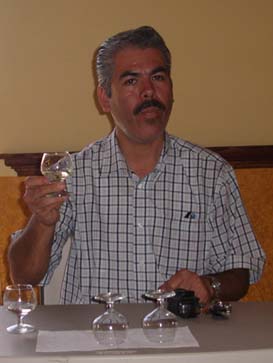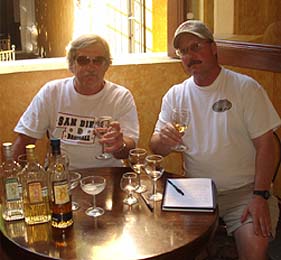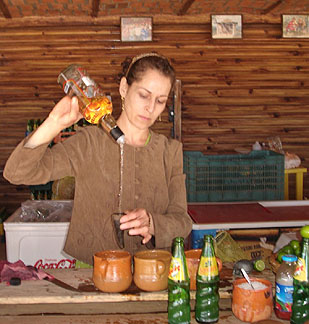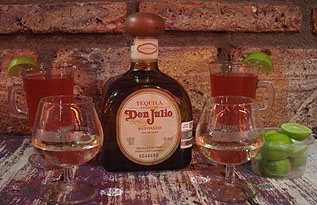|
TASTING TEQUILA
Did you know that tequila has become one of the fastest growing industries in the United States and Mexico? Although this
was largely driven by the popularity of margaritas and chasing down tequila shooters with lime, society is slowly but surely accepting the notion that quality tequila is to be savored like a fine cognac. The evidence is appearing on shelves
throughout America, where you can now find a better selection. Restaurants, bars, stores and people's personal stash now includes more premium 100% agave tequilas than ever before. Sure, there's a time and place for shooters and margaritas. However, you can use less expensive tequila for this purpose. If you are drinking a young tequila made from 51% agave, you may want that salt and lime handy to cover up the harshness. If you are sipping quality tequila, you won't need it. Salt and lime will only interfere with the aromas and flavors that many of us have grown to appreciate. The following assumes you are using a tequila worthy of sipping thus have no need for additives.
 Although tequila tasting is very subjective, experts largely agree how this spirit should be sampled. Here are 5 steps to help maximize the experience.
Although tequila tasting is very subjective, experts largely agree how this spirit should be sampled. Here are 5 steps to help maximize the experience.
1. To begin, you should use a glass that is tapered from the bowl towards the top such as a brandy snifter or wine glass.
This helps channel the aromas and bouquet to the nose. As smell accounts for about 60% of taste, it is important to capture the aroma along with the flavor to fully appreciate the spirit.
2. Pour an ounce or two of tequila in the glass. Observe the hue of the tequila. Generally, the longer the tequila has been aged the darker the color and the stronger the wood flavor. This assumes you are drinking a 100% agave tequila and not a "mixto". Tequilas that are not made from 100% agave could contain additives to give the color an "aged" look. The color can hint towards the tequila's complexity. Aged tequilas can have golden, brass or amber hues and on occasion, a copper-toned appearance. The visual effect is stimulating yet relaxing helping prepare your mood for the next step.
3. Swirl the glass around to free the aromas and observe the body. Notice the tequila tracks cascading down the sides of
the glass. These are known as the legs or tears of the tequila. With extra aged tequilas, the tracks will be slower to
develop (than for a blanco). This is because glycerin is transferred from the oak barrel to the tequila during the aging
process (resulting in a slightly thicker consistency).
4. Now it's time to smell the tequila. Raise the glass up around the mouth and nose to enjoy the bouquet. With your mouth slightly open, slowly sniff the aroma. Try to identify the different scents the tequila has to offer. Experienced tequila tasters can distinguish between the various aromas found in the glass:
a) The lower rim, where you find the basic elements of the spirit.
b) The midsection, where you can identify the dominant notes of the bouquet.
c) The upper rim, where you will have to concentrate to unveil the secondary elements such as floral, herbal, wood and spice accents.
 5. Take a small sip of the tequila and swish it around in your mouth for a few seconds. As you slowly breath in a little air, swirl the tequila over your tongue to help bring out the aroma. Exhale through your nose before swallowing. Your tongue will adapt and the second taste will sting less as you repeat the sequence. As you exhale, analyze the character of the tequila, the agave flavor and the wood tones. If you are sipping a blanco, you can expect a strong agave flavor and more of an alcohol bite. A quality añejo will taste more like a fine cognac, smoother but possibly a less pronounced agave flavor. Many prefer a reposado, which can offer a nice balance between the two. Notice the texture as you sip the spirit. Blancos tend to have a somewhat oily texture whereas aged tequilas can offer more of a silky or even creamy consistency.
5. Take a small sip of the tequila and swish it around in your mouth for a few seconds. As you slowly breath in a little air, swirl the tequila over your tongue to help bring out the aroma. Exhale through your nose before swallowing. Your tongue will adapt and the second taste will sting less as you repeat the sequence. As you exhale, analyze the character of the tequila, the agave flavor and the wood tones. If you are sipping a blanco, you can expect a strong agave flavor and more of an alcohol bite. A quality añejo will taste more like a fine cognac, smoother but possibly a less pronounced agave flavor. Many prefer a reposado, which can offer a nice balance between the two. Notice the texture as you sip the spirit. Blancos tend to have a somewhat oily texture whereas aged tequilas can offer more of a silky or even creamy consistency.
What you eat before or between sips will affect the taste. If you want a pure taste, avoid eating foods with strong flavor and don't wear any flavored lip gloss, perfume, cologne, etc. If you change tequila types/brands, drink some unflavored water to rinse away the previous flavors. Your ability to differentiate between the various complexities will decline if you try too much or too many different types at one setting.
Many elements will impact how a tequila tastes. Where the agave was grown, the maturity of the plant
and the season in which it was harvested can effect the flavor profile. The ingredients, equipment, and methods used during the production process all effect the final product. The type of barrels, the number of times the barrels were previously used, even the size of the aging container can influence the taste. Best thing to do is sample several to determine your preference. You should also realize the characteristics of a specific brand tequila can vary between harvest, and it is at times noticeable to an experienced palate.
Tequila is best enjoyed in moderation. Drink too much and you will wind up with a serious hangover. I've run across several people that avoid tequila because they overindulged on a previous occasion. Know your limitations and try not to over do it. Take your time and savor the flavor. If you develop the ability to distinguish between the multiple characteristics found in various types and brands, you will increase your enjoyment sipping tequila.

There is an "official tequila glass" made by Riedel Crystal in Austria. This glass, designated the Official Tequila Glass by the Consejo Regulador del Tequila in 2001, was introduced simultaneously to the U.S. and Mexico in March of 2002. The Riedel Ouverture (Ouverture Tequila 408/18) is an elegant slender glass 8¼ inches tall with a capacity of
6¾ ounces designed to enhance Mexico's finest tequilas. The glass has a tall stem, meant to lift fine Tequila to the level it deserves, to accord it the appreciation and respect of which it is worthy. The glass was selected by tequila experts who eliminated the competition during four rounds of taste-testing at two different workshops (first workshop held on July 9, 2001 Tequila, Jalisco, Mexico; second workshop held November 4, 2001 Reidel Glassworks in Kufstein, Austria).
 The tradition of drinking tequila shots came from the early days where distilleries were located out in the agave fields and
drinking glasses were in short supply. The hollowed-out tip of a bull's horn was initially used as a shot glass (called a "cuernito"). These were in fairly short supply as well, thus the cuernito was often passed from one drinker to another. The curved horn was difficult to set down without spilling, thus patrons employed the "down-the-hatch" method, which remains a widely used style of drinking tequila today. Some bartenders still use the traditional bull's horn as a shot glass. Pictured here is the bartender at Jarritos El Guero #1 located at K49 Carretera International (on route 15 between the towns of Tequila and Amatitan, Jalisco, Mexico). Today, the commonly used shot glass is known as a "caballito" meaning "little horse". However, many Mexican cantinas now serve their premium tequilas in a small glass shaped like a brandy snifter to allow for better enjoyment of the body and bouquet.
The tradition of drinking tequila shots came from the early days where distilleries were located out in the agave fields and
drinking glasses were in short supply. The hollowed-out tip of a bull's horn was initially used as a shot glass (called a "cuernito"). These were in fairly short supply as well, thus the cuernito was often passed from one drinker to another. The curved horn was difficult to set down without spilling, thus patrons employed the "down-the-hatch" method, which remains a widely used style of drinking tequila today. Some bartenders still use the traditional bull's horn as a shot glass. Pictured here is the bartender at Jarritos El Guero #1 located at K49 Carretera International (on route 15 between the towns of Tequila and Amatitan, Jalisco, Mexico). Today, the commonly used shot glass is known as a "caballito" meaning "little horse". However, many Mexican cantinas now serve their premium tequilas in a small glass shaped like a brandy snifter to allow for better enjoyment of the body and bouquet.
 One traditional method of drinking tequila in Mexico is to alternate between sips of tequila and Sangrita. Sangrita is a
non-alcoholic drink with tomato, orange, red pepper and lime flavor. Many feel it compliments the tequila. It is normally
paired with a blanco or reposado. Sangrita is widely available at Liquor stores in Mexico, but it is best to make it
yourself using fresh ingredients. Visit our
Sangrita Recipes section for detailed instructions on how to make Sangrita.
One traditional method of drinking tequila in Mexico is to alternate between sips of tequila and Sangrita. Sangrita is a
non-alcoholic drink with tomato, orange, red pepper and lime flavor. Many feel it compliments the tequila. It is normally
paired with a blanco or reposado. Sangrita is widely available at Liquor stores in Mexico, but it is best to make it
yourself using fresh ingredients. Visit our
Sangrita Recipes section for detailed instructions on how to make Sangrita.
|





